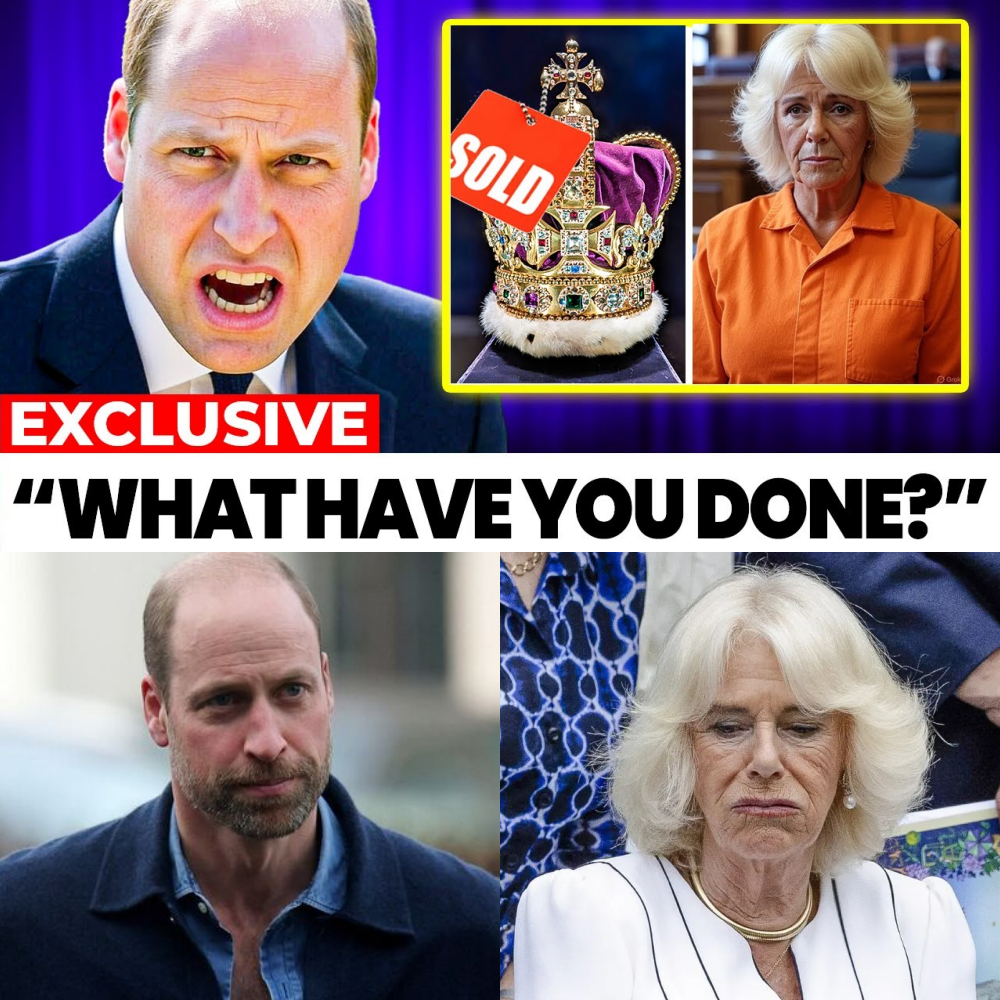
It was the kind of palace scandal no one thought possible. For centuries, Britain’s monarchy has stood as a symbol of continuity, dignity, and unshakable tradition. But behind the gilded walls of Buckingham Palace, whispers grew louder, corridors grew colder, and suspicion swirled like a storm.
By dawn, the monarchy was facing a crisis so severe that Prince William was forced to make a decision that shook the institution to its very core: stripping Queen Camilla of her title as Queen Consort.
The reason? The unthinkable — her alleged involvement in the disappearance and secret sale of priceless royal jewels.
A Scandal Begins
The trouble began quietly, as all scandals do. During a routine inventory of the royal vaults, staff noticed irregularities. A necklace here, a tiara there — pieces with documented provenance stretching back to Queen Victoria — had vanished.
At first, murmurs were kept discreet. Assistants lowered their voices when certain names were mentioned, and senior aides avoided speaking about the missing heirlooms at all. Yet the losses mounted, and the tension inside the palace became undeniable.
For an institution that relies on legacy, every missing jewel felt like a fracture in the crown itself.
Prince William, poised as the future king and determined to safeguard the monarchy’s credibility, decided he could no longer ignore the whispers.
The Secret Investigation
Rather than risk a public spectacle, William quietly enlisted the help of Harkort, a discreet former intelligence officer with experience in financial crimes. The task: uncover the truth without setting off a constitutional crisis.
What followed was a months-long investigation that unraveled a scheme far darker than anyone had expected.
Harkort’s meticulous work uncovered trails leading to high-end European auction houses. Items described vaguely as “estate jewelry” bore uncanny resemblance to pieces once photographed on the late Queen Mother. The auctions were intentionally obscure, with buyers shielded by shell companies and intermediaries.
It was clear: someone with access — someone trusted — was moving jewels out of the royal collection.
The First Shocking Connection
The breakthrough came when a retired appraiser stepped forward, recalling he had been asked to discreetly evaluate jewels for a private client. The descriptions matched royal heirlooms. The appraiser, assuming the client had legitimate ownership, thought little of it at the time.
But when pressed, he revealed the request had come through a well-connected intermediary: Charles Everly, a former royal aide.
Everly had once enjoyed the palace’s full trust, with deep ties to European collectors. Now, he emerged as the linchpin in the unfolding scandal.
The Queen Consort’s Shadow
Even more stunning was the next revelation: evidence suggesting Queen Camilla herself had been directly involved.
Travel logs, auction records, and Everly’s correspondence revealed transactions timed precisely with her private trips abroad. Documents suggested she leveraged her royal status to quietly move pieces without drawing suspicion.
It was, for William, the most devastating possibility of all. Not only had jewels gone missing — but the very woman crowned beside his father appeared complicit.
The Confrontation
The palace’s atmosphere grew icy as rumors spread internally. Staff tiptoed around Camilla, while William wrestled with an impossible choice: protect his family’s unity or protect the monarchy’s honor.
Finally, he chose confrontation.
In the stately Blue Drawing Room of Buckingham Palace, William faced Camilla. The setting — regal, formal, and steeped in history — underscored the gravity of what was at stake.
Those present described the exchange as tense, almost unbearable. William, known for his measured temperament, reportedly spoke with restrained fury. Camilla, equally unflinching, denied outright theft but struggled to explain the mounting evidence.
By the meeting’s end, the gulf between them was unbridgeable.
The Unprecedented Decision
Weeks later, William made his decision public. In an extraordinary press conference from the palace’s media room, he announced that Camilla would no longer hold the title of Queen Consort.
His words were stark: “The monarchy exists to protect the crown, not to be shielded by it. Accountability must apply to all of us — without exception.”
The announcement sent shockwaves across Britain and beyond. For centuries, royal titles had been sacrosanct. Never before had a senior royal been stripped in such a dramatic and public fashion.
Fallout Inside and Outside the Palace
Camilla’s sudden absence from public duties only fueled speculation. Reporters clamored for answers, tabloids ran screaming headlines, and social media exploded with theories.
Inside the palace, staff adopted strained politeness. Ceremonial duties were reshuffled, titles updated, and security around the royal vaults tightened to levels unseen in decades. New oversight measures now required multiple approvals before any item could leave royal storage.
The monarchy, battered by scandal, was in full damage-control mode.
The Public Reacts
Public opinion was sharply divided. Some praised William for his courage, calling him the only royal strong enough to prioritize duty over blood. Others accused him of tearing the family apart at a time when unity was most needed.
For monarchists, the scandal was a devastating blow to the institution’s credibility. For republicans, it was evidence of deep dysfunction in a system that should no longer exist.
Yet for William, the path was clear. He had chosen preservation of the crown above all else.
A New Era of Royal Accountability?
Whether Camilla’s alleged role was one of mastermind, accomplice, or scapegoat remains the subject of fierce debate. What is certain is that William’s decision marked a turning point in modern royal history.
By stripping Camilla of her title, he sent a message that no one — not even the Queen Consort herself — is above accountability.
For a monarchy often criticized for secrecy and privilege, it was both a shocking rupture and a signal of evolution.
As the dust settles, one truth remains: the jewels may glitter, but trust is the crown’s most precious possession. And once lost, it may never be restored.
📌 Disclaimer: This article is based on publicly available reports, commentary, and speculative analysis. Certain details have been dramatized for narrative effect.